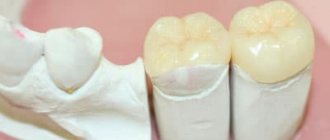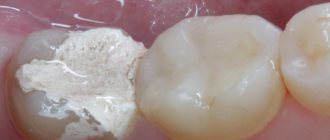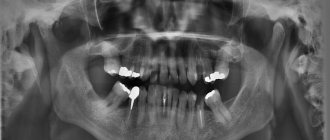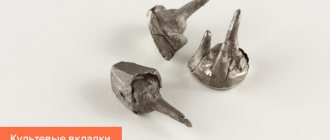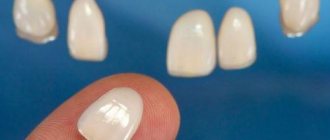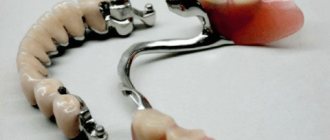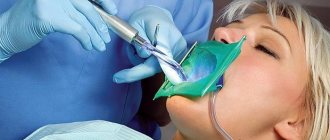Sometimes in dentistry a moment arises when a regular filling is not enough, but covering a tooth with a crown is still blasphemous. Then a diverse group of tabs comes to the rescue. Diverse in types and manufacturing methods. Inlays are prostheses (or microprostheses) that restore defects in the hard tissues of teeth, and as a result, the function and aesthetics of individual teeth and the entire dental system.
But they are not common. Not that they are extremely rare, but like marginals, they are on the border of two large restoration paths, and each of them is trying to occupy a large niche. On the one hand, these are fillings that are made here and now, quite quickly and cost-effectively. Another niche is crowns, which are used for more significant defects, and also occur in cases where an inlay can be used, but due to their higher functional qualities, longer service life and better aesthetics, they are more widespread among doctors.
Then why do we need them? But because they are more perfect than fillings in functional terms, and are more tolerant of tooth tissues than crowns, but in a harsh market they find themselves in the background.
What is a dental inlay?
At its core, a dental inlay is a large filling. Only it is not made by a dentist in the patient’s mouth, but in a dental laboratory using individual impressions. Due to this, the design more accurately follows the shape of the cavity and fits more tightly to the tooth tissue, which minimizes the risk of caries at the junction between the inlay and the tooth.
Inlays, which are used instead of fillings, are often confused with dental cores. These are completely different designs. Let's start with the fact that a dental inlay, instead of a filling, is a restoration element of the crown part of the tooth, and a stump inlay is technical, since it serves as a support for an artificial crown when the tooth is destroyed by more than 2/3. To make it easier for patients to remember the difference, I would differentiate these prostheses as follows: the dental inlay is located outside the living tooth, and the stump inlay is located under the crown.
Indications and contraindications for the installation of stump inlays
Indications for installation
Restoring teeth with core inlays is possible only if there is firm confidence in the reliability of the root and in the absence of any pathological processes in the periodontal tissues. The length of the root canal into which the cast post is installed must be greater than the height of the artificial crown, and the walls of the tooth must be thick enough to withstand the chewing load.
Contraindications for use
The main contraindications to prosthetics with stump inlays are:
- obstruction of the root canal or its curvature;
- pronounced changes in periodontal tissues in the absence of the ability to block the development of the pathological process;
- improper root length or tooth wall thickness;
- pathological mobility of teeth;
- incomplete filling of root canals.
Inlays and veneers - what's the difference?
Both inlays and veneers belong to microprosthetic technology and are used to restore damaged teeth. However, there are fundamental differences between them.
| Tabs | Veneers |
| Used to reconstruct any side of the tooth surface | Used to restore the outer wall of the dentition |
| Installed on chewing teeth | Fixed in the smile area |
| Recreates the natural shape and functionality of teeth | Intended for aesthetic restoration only |
| Made from gold, metal alloys, zirconium oxide for increased product strength | Created from ceramics, zirconium oxide and composite materials for an absolute appearance identical to natural teeth |
If you are unsure which design is suitable for your case, consult your dentist. He will conduct an examination and help you choose the most suitable option.
Composition and application of microprosthesis
Compound
The prosthetic structure consists of a pin part that completely follows the shape of the root canal, and a stump that imitates the crown being restored. Most often, stump inlays are made from various metal alloys through precision casting. However, zirconium or aluminum oxide can also be used to produce prostheses.
Application
Standard cast pins are used to create tooth stumps with pronounced destruction of their supragingival part and the presence of healthy, strong roots. In this case, the tab is tightly fixed in the root canal so that its stump part protrudes above the gum. The stump can be used as a support for crowns, splinting structures, removable and fixed dentures.
In modern dental practice, collapsible and non-removable stump inlays are used.
Non-removable structures are used to restore teeth with one root, and collapsible ones are used to create tooth stumps with two or more roots.
What are the advantages of dental inlays?
In addition to the manufacturing technology, dentures in the form of inlays differ from fillings in the following parameters:
- Firstly, they are much stronger and more durable than fillings. For example, the service life of a ceramic inlay is 20 - 25 years. Not a single filling is capable of performing its functions efficiently for such a long period. It wears out faster and needs to be replaced. If this is not done, due to a violation of its anatomical shape, the bite begins to be fixed differently, the tooth no longer chews food so effectively, the patient has to make additional efforts, which negatively affects the jaw joints, provoking their diseases.
- Secondly, dental prosthetics with ceramic inlays reliably protects the tooth from further destruction, since ceramics is a durable material that can withstand any chewing and temperature loads. This is the only option for tooth restoration that helps to avoid subsequent pulp removal and crown covering.
Dental restoration with inlays
- The purpose of the tab or what it is
- The superiority of an inlay over a filling
- Types of tabs
- List of indications and contraindications
- Advantages of materials for making inlays
- Description of manufacturing stages and techniques
- Features of the preparatory procedure
- Installation Procedure Steps
- Why does pain occur after installing tabs?
- Recommendations for dental care after the procedure
- How much does a tooth tab cost?
- FAQ
Since childhood, human teeth are subject to regular stress, as a result of which they lose their original functionality and are destroyed under the influence of external factors.
The appearance of holes and other defects is a clear reason to sign up for a free consultation with Aesculapius specialists. The doctors of our dental center provide emergency therapeutic and surgical treatment of dental diseases.
Restoring the shape of the oral organ and hard tissues is one of them. A ceramic tooth inlay will help solve the problem of loss of functionality and aesthetic properties. It serves as a worthy alternative to fillings, surpassing them in many respects.
Specialists will identify the problem and offer the most suitable microprosthesis. Inlays are a reliable restoration of teeth after serious carious lesions, chips, and destruction.
What are the pros and cons of different types of tabs?
Many patients are interested in what dental inlays are made of. Based on the material they are made of, they are divided into metal (an alloy of cobalt and chromium), ceramic, zirconium and composite. In this regard, the pros and cons of dental inlays in dentistry are different. The doctor, together with the patient, decides on the choice of design from one material or another, guided by the characteristics of each clinical case separately.
Ceramic
The best ones are E-max ceramic dental inlays, which consist of almost the same advantages. They are the most aesthetic and reliable. Their wear rate is the same as that of natural teeth. In addition, ceramic inlays have the tightest fit to the living tissues of the tooth, thus minimizing the risk of developing secondary caries. But they still have one drawback. This is quite a high price. Zirconium inlays are also a worthy choice; they are very durable, but their adhesion to tooth tissue is worse than ceramic ones.
Composite
Composite inlays made from conventional filling material are not as strong as metal, ceramic or zirconium, but they do not have the following disadvantages that are inherent in fillings made directly in the patient’s mouth.
- The composite dental inlay does not sag. If you put a large filling instead, it will not withstand the load and will tear away from living tissue, creating tension on the walls of the tooth and causing its destruction or injury. This is absolutely not typical for a composite dental inlay.
- Composite inlays do not cause problems with bite and chewing functions. They are made from individual impressions, taking into account the antagonists, that is, the adjacent teeth with which the tooth being restored comes into contact.
Metal
In our clinic, metal dental inlays are used only as a temporary option, since they often cause galvanism in patients, that is, a reaction to the influence of galvanic currents occurring in the oral cavity. This phenomenon is accompanied by a metallic taste in the mouth, a burning sensation, and increased salivation. In addition, the disadvantages of metal inlays include their poor adhesion to tooth tissues, and, as a result, their loss. Among the advantages of these restorations, one can only note their strength and hypoallergenic material. It should be noted that before the advent of ceramics, similar designs made of gold were popular - a soft metal that provided a tighter fit.
Composite inlays have a special advantage that, unfortunately, is missing from other types - they can be repaired in the oral cavity using composite filling materials, and they will continue to successfully fulfill their purpose. Therefore, composite inlays are also installed in cases where, after endodontic treatment of the tooth canals, there is no confidence that they will not have to be re-treated again. If necessary, you can always open them and carry out all the necessary manipulations. Other types of inlays cannot be repaired because the materials from which they are made do not have adhesion to the composite.
Recommendations for dental care after the procedure
To avoid premature damage to the insert, our doctors inform you about the specifics of daily hygiene measures.
The rules of care are simple:
- Brushing your teeth at least 2 times a day.
- Use mouthwash after every meal.
- Consuming mainly products after heat treatment to avoid excessive loads on the tab.
- Annual visit to the dentist. Regular examinations make it possible to eliminate the slightest damage to structures and carry out dental corrective measures in a timely manner.
If damage is detected, emergency dental care is important. Bacteria penetrate into places where there are chips or displacements. Harmful microorganisms provoke active tooth destruction. Ignoring the rules of oral care and the recommendations of the treating doctor leads to irreversible consequences.
How is a dental inlay installed?
Basically, such prostheses are installed on living teeth, since if the tooth’s nerve is removed, or there is such a need, it means that the tooth is severely damaged and to restore it, it is no longer necessary to have an inlay, but a crown. The installation of a dental inlay occurs in four stages:
- Diagnostics
. First, it is necessary to examine the patient and carry out appropriate diagnostic procedures - take X-rays and computed tomography to obtain a more objective picture of the clinical case. However, it is possible to identify the need to install an inlay and adequately assess the degree of tooth destruction only after preparing the cavity.
- Preparation
. Many patients believe that a dental inlay will require more serious tooth preparation with the removal of a large amount of its tissue. This is not true. The tooth is ground down exactly as much as necessary depending on its destruction. You should not think that the doctor will specifically “bring” the cavity to the size at which the installation of a dental inlay is indicated. In our clinic, we always use the most gentle techniques and try to preserve living tooth tissue as much as possible.
- Manufacturing
. Typically, the time it takes for structures to be ready depends on the workload of the dental laboratory, but, as a rule, the manufacturing process takes about 7 days for any type of inlay.
- Fixation
. Before installing the inlay, the tooth cavity is sandblasted to create an adhesive surface. Next, the microprosthesis is fixed in the cavity with composite cement, and the exit points of the fixing material are ground. After this, occlusal contacts are checked using articulation paper to create multi-point contact of the prosthesis with antagonist teeth.
Installation Procedure Steps
After receiving the inlay, they begin to remove the temporary structure and install the finished inlay. The procedure is similar to traditional prosthetics. First, the doctor conducts a second examination of the oral cavity, gives the necessary recommendations, and talks about the stages of the planned treatment.
The affected tooth tissues have already been removed before installing the finished inlay. “Aesculapius” specialists clean the cavity during treatment of the oral cavity at the previous appointment. The tab is fixed using a special adhesive composition. The design fully corresponds to the size and shape of the recess.
After the introduction of the microprosthesis, neither gaps nor other defects arise. The final step is polishing the tab. This procedure smoothes out the external discrepancy between natural fabrics and the insertion element.
What are the features of making dental inlays?
The inlay is made in dental laboratories using impressions of the patient’s teeth and jaws so that it matches the shape of the dental cavity as accurately as possible and ensures correct contact with other teeth without disturbing the bite. Depending on the material of the structure, a certain technology is used for its manufacture.
If we are talking about ceramic inlays, then first a porcelain frame is made by pressing, and then ceramic mass is applied to it in layers. Metal inlays are cast, and zirconium inlays are produced by digital modeling and milling using an innovative CAD/CAM system. Composite microprostheses are made from a plaster model of the tooth and are polymerized using light or heat.
Photos before and after installing a dental inlay
Features of the preparatory procedure
In order for the installation to be successful, Aesculapius dentists do not miss a single item from the list below:
- In-depth analysis of the condition of the oral cavity
- Drawing up a unique treatment program for each patient
- Performing high-quality preparation and treatment of the dentition
- Taking an impression
- Creation and installation of a temporary crown
Experts are well aware of the following: the final result depends on the quality of preparation.
What are the quality parameters of dental prosthetics with inlays?
If the technology was violated during the process of fixing the inlay, or the patient has not undergone preventive examinations for years, then secondary caries may occur at the border of the contact of the microprosthesis with the dental tissues. Then it will be necessary to carry out treatment and remove the dental inlay. At the same time, the design itself does not in any way stimulate the occurrence of caries. To avoid it, the main thing is to prevent technological inaccuracies during the installation process, so that the tightness of the dental inlay with filling the cavity with composite cement is equal to 0.004 microns. It is also important to ensure that there are no overhanging edges for a complete aesthetic and functional restoration of the tooth.
If the tab is installed correctly, then it does not provoke an increase in tooth sensitivity, and if not, then the antagonist tooth may begin to react to irritants due to malocclusion.
If pain occurs as a result of complications such as caries, pulpitis or periodontitis, the dental inlay must be opened and appropriate treatment carried out. After which this microprosthesis will need to be replaced with a new one.
Why does pain occur after installing tabs?
The competent professional approach of Aesculapius specialists guarantees the absence of discomfort after the microprosthetics procedure. Techniques and materials allow you to select the most suitable hermetic inlay, taking into account the individual characteristics of the patient.
However, the body's increased sensitivity to established foreign bodies can cause pain. The appearance of discomfort is a reason to make an unplanned visit to the dental center. Pain occurs due to the body’s rejection of an inlay made of a particular alloy.
Why is it important to contact your doctor immediately? There is a high probability of developing a regressive process of tooth decay. Indifference to pain ends in loss of the oral organ. When undergoing treatment from a specialist at another clinic, patients also turn to professional help at Aesculapius. The inspection may reveal the following:
- incorrect tab selection
- lack of tightness
- violation of the stages of installation of a microprosthesis
The pain is a consequence of the presence of gaps, which is unacceptable. Caries continues to progress in the gaps. Discomfort also occurs after more than one year of wearing the insert.
Why? The time for replacement is approaching. Miniature prostheses do not last forever; after the expiration of their working life, they need to be removed. To avoid such consequences of prolonged wear, we must not forget about regular preventive visits.
Can pain occur due to toxic materials? No, modern dental compounds are absolutely safe for human health.
What materials are used
The most common materials are liquid and plastic composites, synthetic polymers that harden due to a chemical reaction, incl. under the influence of light. In essence, this is an ordinary composite filling composition - but processing in a laboratory makes it less susceptible to subsidence and abrasion. The liquid composite is used as the base material for temporary restorative inlays or as a lining for a fiberglass post (for stumps). For example, Tempocor brands from VladMiVa and Dia-Temp from DiaDent are used for temporary restorations.
For long-term restorations, solid blocks for milling are used - Tetric CAD from Ivoclar Vivadent, Paradigm MZ100 from 3M ESPE, hybrid blocks Grandio blocs from VOCO. Materials for milling are denser and stronger, wear less easily during use, and practically do not sag over time.
Zirconium dioxide
The most modern development is a zirconium dioxide inlay - a material that is obtained from solid zirconium. It is more expensive than its analogues, but has no disadvantages at all. This tab is durable, aesthetic, and hypoallergenic. It can be used on both the front and lateral teeth. If you decide to install a stump inlay, the material for it should be selected together with your doctor. He will test you for compatibility between your body and the components that will make up the prosthesis. The structure is placed for a long time, and therefore, in case of incompatibility, removing it will be quite problematic - you will have to remove it along with the tooth.
Zirconium dioxide core inlay
Complications after prosthetics
Most often, complications are associated with errors1 at the preparation, manufacturing or installation stage. For example, due to an incorrectly selected shade, the restoration may stand out from the crowd. If tissues affected by caries remain in the cavity, if the microprosthesis is too high or too low (relative to the rest of the row), scratches appear on the contact teeth or gums - this is also considered a complication, which is often accompanied by pain.
What to do if a tooth hurts under the tab? You should definitely contact your orthopedic dentist, who will conduct a diagnosis and find the cause of the pain. It is possible that a new prosthesis will have to be made for this.
NeoStom – Dentistry website
The manufacturing method and the sequence of clinical and laboratory stages of making the inlay depend on the material for its manufacture. The following methods are used: • with the preliminary creation of a wax model of the inlay with its subsequent replacement with metal (by model-free casting or casting on a refractory model), with plastic (by molding method), with ceramics (by injection molding method);• modeling an inlay made of composite materials directly on a working model of a tooth stump made of supergypsum or ceramic masses on a refractory model; • computer milling of ceramic inlays.
To remove the inlay from the cavity, use a metal pin made of orthodontic wire with a diameter of 0.8-1.0 mm and a length of 1.5-2.0 cm, the heated end of which is carefully inserted into the wax. The position of the pin in the wax should correspond to the path of insertion and removal of the insert from the cavity in one direction. Large tabs are removed from the cavity using a U-shaped bent wire pin. If there are no signs of deformation, the wax model of the inlay is sent to a technical laboratory, and the cavity is closed with a temporary filling. The technique of making a cast metal inlay from a wax model obtained in the mouth was first described by Taggart in 1907. The direct method of making inlays has certain advantages and disadvantages. Advantages of the direct method: • higher accuracy of the resulting wax model of the inlay - there is no need to obtain an impression and a plaster model, for the production of which auxiliary materials with volumetric changes are used; • the ability to eliminate deficiencies in the preparation of the tooth cavity: if the inlay becomes deformed when removed from the cavity, during the same visit it is possible to identify and eliminate the deficiencies of the preparation with repeated modeling of the inlay; • the ability to control the boundaries of the inlay in the area of the gingival margin, which is important for the prevention of inflammatory changes in the mucous membrane; • the ability to model an inlay taking into account the articulatory relationships of the restored and antagonizing pairs of teeth. Disadvantages of the direct method: • difficulties associated with insufficient visibility of the surgical field in the area of the lateral group of teeth, increased salivation; • the possibility of thermal injury to the oral mucosa with a hot modeling tool when working with wax; To obtain a tab model, two traditional methods are used: direct and indirect. Direct method of making inlays In the direct method, the inlay is modeled directly in the patient's oral cavity, followed by replacing the wax with the main material of the inlay in a dental laboratory (Fig. 1-7).
Rice. 1-7. Scheme of clinical and laboratory stages of manufacturing inlays using the direct method
Modeling an inlay in the oral cavity is performed as follows. First, in order to control the quality of cavity formation, a stick of modeling wax, heated to a plastic state, is pressed into it. After hardening, the wax is removed from the cavity. If the cavity is formed correctly, then the wax is removed from the cavity and reintroduced into it without deforming the surface. If areas of deformation of the cavity imprint on the wax or difficulties in removing wax from the cavity are determined, then areas of retention are identified and they are ground off. After this, they proceed directly to modeling the tab. A stick of heated wax is again pressed into the formed cavity and its excess is cut off. While the wax remains flexible, the patient is asked to close the teeth in a position of central occlusion, and then simulate chewing movements. In this case, the surface of the inlay takes on a shape characteristic of functional occlusion. Subsequent modeling is aimed at restoring the anatomical shape of the destroyed part of the tooth crown (deepening fissures, forming cusp slopes, restoring the equator). Modeling of the chewing surface is carried out taking into account the age-related characteristics of the structure of the teeth.
• a large amount of time spent by a doctor on performing the technical procedure for modeling inlays with a large number of teeth being restored; • tediousness of the procedure for modeling inlays with a large number of teeth being restored for the patient. For these reasons, the range of indications for the use of the direct method of making inlays is limited to easily accessible cavities on the chewing or cervical surfaces. Indirect method of making inlays In modern orthopedic dentistry, inlays are often made by an indirect method, the use of which is indicated for all types of dental defects, including: • for defects of molar and premolar crowns of the MO, OD, MOD types; • defects in the contact surfaces of incisors and canines, both with and without damage to the cutting edge; • making inlays for adjacent teeth. Using this method, inlays can be made from all types of materials: metals, plastics, composites, cast ceramics, porcelain, combinations of materials. With the indirect method, the entire process of making an inlay - from the moment of creating the wax composition or the inlay itself - is carried out directly in the dental laboratory on a model (Fig. 1-8-1-10).
Rice. 1-8. Scheme of clinical and laboratory stages of manufacturing metal and plastic inlays by indirect (reverse) method
After the cavity is formed in the tooth, the doctor takes an impression using elastomeric impression compounds (silicone, polysulfide, polyester). The impression must convey all the details of the tissues of the prosthetic bed with the maximum degree of accuracy, which is achieved by obtaining a two-layer impression. Based on the impression received, the technician casts a working model. The working model of the dentition is usually made using a combined collapsible model. The collapsible model allows you to pre-fit the insert and control the tightness of its fit. Depending on the material used to make the inlay, the model of the prepared tooth can be made of supergypsum or duplicated from a refractory material.
Inlays from polymeric materials can be created without first making a wax model of the inlay. For this, light-curing polymers are used, which are sequentially introduced layer by layer (in layers up to 2 mm) into the cavity and polymerized layer by layer in special devices. Inlays are usually fixed using dual-curing composite materials or glass ionomer cements. Before fixing, the internal surfaces of the inlay must be specially prepared depending on the construction material used. Before fixing the composite tab, its internal surfaces are treated in a sandblasting machine. This promotes effective adhesion of the inlay surface to the fixing material by creating a larger contact area and micromechanical retention. Before fixing the ceramic inlays, the inner surface of the inlay is etched with hydrofluoric acid and silanized. The production of combined inlays involves the sequential creation of two parts of the structure - a metal frame and a polymer (compomer or ceramic) lining. When making a metal-plastic insert, a metal frame is first made, which is adjacent to the bottom and walls of the cavity. The frame is modeled on a collapsible wax model so that its thickness is 1.5-2.0 mm less than the thickness of the inlay. Retention balls with a diameter of up to 0.6 mm are applied to the outer surfaces of the wax frame, with the help of which conditions are created for the mechanical fastening of the polymer lining. Replacing the wax composition of the frame with a metal alloy is carried out according to generally accepted methods. After casting, the metal frame is fitted onto the collapsible combined model and into the oral cavity.
The manufacture of polymer cladding is carried out in one of the following ways: • modeling the cladding directly on the metal frame of the inlay with polymer; • modeling of wax lining with its subsequent replacement with polymer material;
• the impossibility of using methods to compensate for metal shrinkage during casting and to provide free space for the fixing material (coating the walls and bottom of the cavity on the model with an insulating varnish); • insufficient accuracy when modeling the approximal walls of the tooth in the area of the gingival papilla; • the need to re-model the inlay if its casting is unsuccessful; • the impossibility of preliminary fitting on the model, which increases the time of its correction in the oral cavity.
Rice. 1-9. Scheme of clinical and laboratory stages of manufacturing composite and ceramic inlays using an indirect (indirect) method
Rice. 1-10. Scheme of the clinical and laboratory stages of making a porcelain inlay
The technology of lining the metal frame of the inlay with a compomer or keromer is similar to the sequence of manufacturing a metal-plastic inlay with some features: • applying a binder layer to the metal frame of the inlay; • sequential layer-by-layer application of compomer material; • light curing in a special apparatus. To make a metal-ceramic inlay, the metal frame is cast from a cobalt-chrome alloy, and before applying the ceramic it is subjected to heat treatment - firing to create an oxide film for reliable adhesion to the ceramic coating. Method for computer milling of ceramic inlays In order to optimize and increase the efficiency of a doctor’s work, computer technologies for milling inlays from ceramic materials ( CEREC ) have been created. The use of this technology eliminates the use of dental technician labor and allows the manufacture and installation of ceramic inlays directly in the clinic during one patient visit.
Using this method, inlays are made from a standard ceramic block, so such microprostheses are characterized by higher strength indicators. The advantages of computer technology for making inlays include the elimination of the clinical stage of obtaining impressions and the technical stage of obtaining models, which saves time for the doctor, technician, and patient. In addition, the absence of the need to obtain impressions and models (materials for the manufacture of which differ in the variability of volumetric parameters) leads to an increase in the accuracy of manufacturing inlays. The formation of a cavity for an inlay is carried out according to generally accepted rules, with the peculiarities of preparation for ceramic structures. The cavity is formed with slightly diverging walls (no more than 4-6°). This is necessary to obtain an accurate “optical impression”, in which the inner and outer edges of the cavity are simultaneously visible in one projection. After this, an “optical impression” of the prosthetic tooth and adjacent teeth, as well as the occlusal surface of antagonist teeth, is obtained using an intraoral video camera. The image of the cavity, information about its size and shape, as well as the contours of the chewing surface of the antagonist teeth are transmitted to the monitor screen. Using a special program, the image is processed, and the dentist carries out computer modeling of the structure, taking into account approximal contacts, static and dynamic occlusion. Based on the virtual model of the inlay, the inlay is manufactured from a standard ceramic blank on a special milling and grinding machine with program control. The process of milling the inlay takes no more than 15 minutes, after which the inlay is fitted in the oral cavity. After appropriate preparation, the tab is fixed. Occlusal contacts are finally adjusted after its fixation.
You might be interested in:
- Manufacturing of temporary dentures using matrix technology
- Manufacturing of temporary dentures
- Methods for making veneers
- Preparation of teeth for veneers. Fixation of veneers
- Treatment with veneers
Related materials:
- Preparing cavities for an inlay
- Application of tabs (classification of tabs)
- Theoretical foundations of tooth preparation
- Types of dentures
- Examination methods for defects of hard dental tissues
Next >>
Manufacturing technology
- The method of layering ceramics. After receiving the impressions, a refractory model is made, a ceramic pin is tightly installed in the channel, ceramic is applied to it, and firing is performed. In the process of applying ceramic layers, it is possible to choose different colors and shades of the material, dyes and modifiers.
- Production of ceramics from tablet molds by pressing. An inlay is modeled from wax, and sprues are installed in the direction of the ceramic flow. Using a silicone ring, investment material is introduced and a limiter is placed. Pressing is carried out in an oven equipped with a microprocessor control system. The resulting product after pressing and casting is a solid single crystal, the abrasion of which is comparable to the natural abrasion of hard dental tissues.
- Manufacturing using CAD/CAM method. Allows you to form prostheses and parts that match the implant, abutment, and the shape of the tooth stump. The unit is scanned in the mouth or on a model, 3D modeling is carried out using a special program, the information received is transferred to a milling machine, which mills the product under computer control. The method is precise and complex, requiring high costs for professional training of personnel to operate the equipment.
- Injection molding manufacturing method. Casting a working model from plaster/polyurethane, selecting an ashless pin similar to the root canal, applying silicone varnish to the root. The pin is inserted into the canal and modeling is carried out with ashless plastic/wax. After a control check, the cast stump insert is removed and transferred to a metal casting. The method is technologically easy, low-cost, requires a minimum of material costs, but is very sensitive to the quality of casting. With strict adherence to all norms and rules, reliable and high-quality microprostheses are obtained.
Alternative prosthetic options
Currently, dentists practically do not use composite materials for inlays. Or they are used, but only for temporary restorations. Because there are other, much better materials. The best alternative to composite is ceramics (pressed, leucite glass ceramics or materials based on lithium disilicate), as well as the strongest aluminum and zirconium dioxides. Ceramics are considered the best in terms of aesthetics, and they will last at least 10 years. Zirconium dioxide and aluminum oxide are slightly less aesthetically pleasing (but this drawback can be solved with the help of facing materials), but they have the longest service life - from 20 years.
Complications and errors
Errors in the manufacture of core inlays are divided into two groups: those associated with the work of the orthopedic dentist and the actions of the dental technician.
Clinical:
- unsealing of the canal to an unsatisfactory amount;
- root perforation during turning;
- giving an inadequate shape to the channel, which can lead to de-cementing of the structure;
- errors when taking impressions.
Laboratory:
- poor-quality casting when using the casting method;
- non-compliance with processing standards during the pressing method;
- violation of the firing regime when applying ceramic layers.
Quality criteria for core restoration: high aesthetic level, reliable fixation, long service life, uniform distribution of pressure when pressed.
